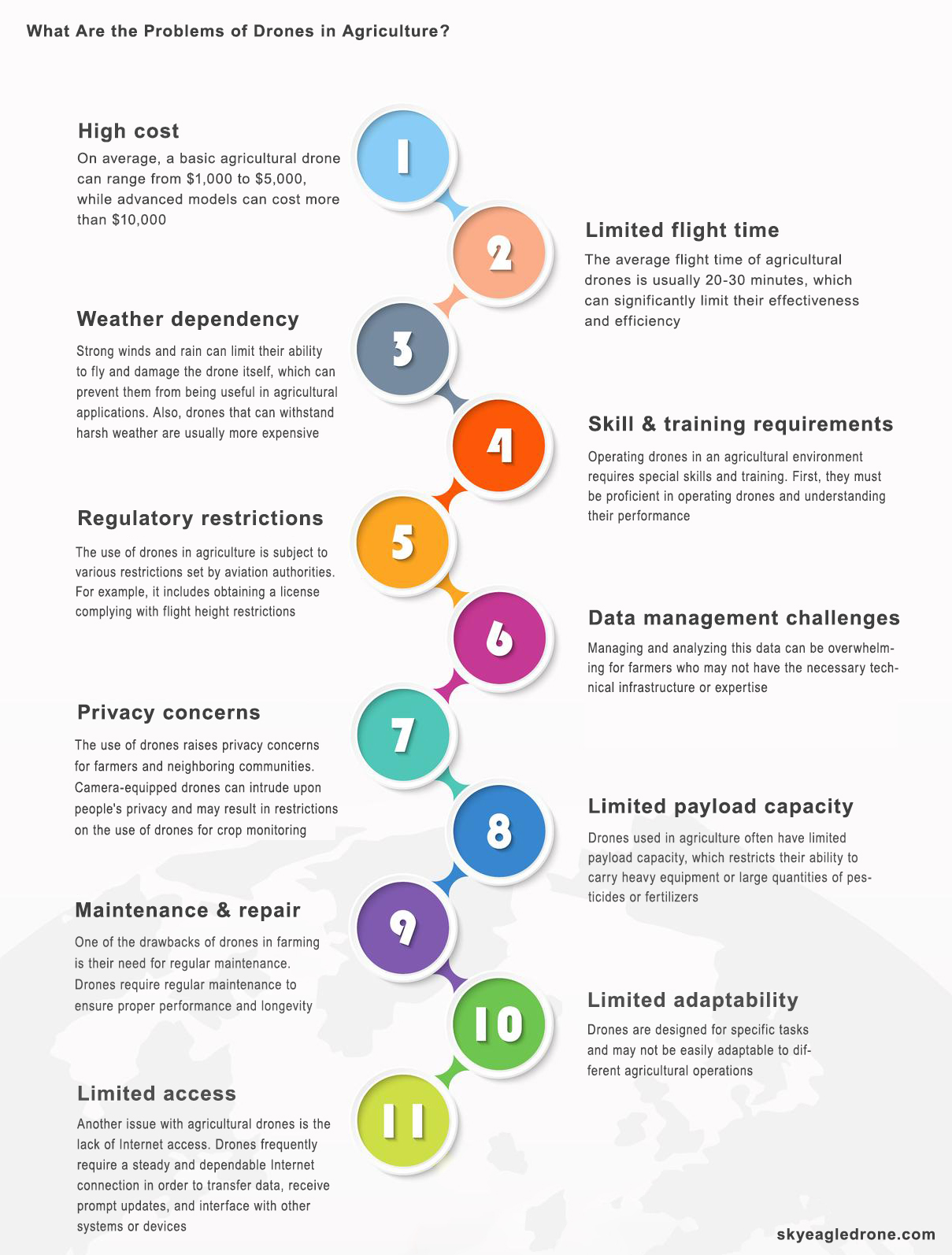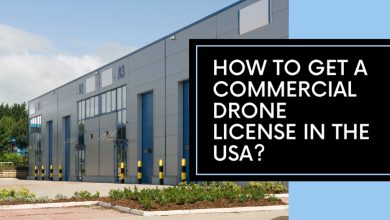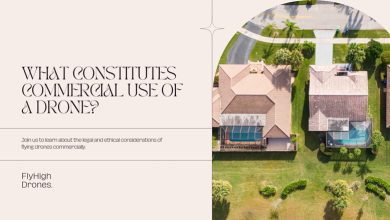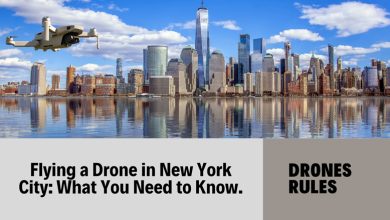What Are the Problems of Drones in Agriculture?
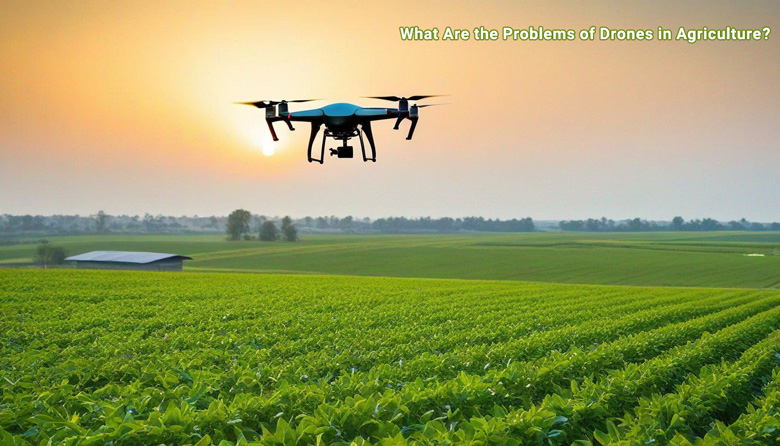
Drones have been a major change in agriculture that has helped farmers a lot. Their ability to simplify various agricultural processes such as precision spraying, pest monitoring, disease diagnosis, and mapping are useful cost savings.
But there is another aspect of using this new technology. Although this device helps a lot, it also creates challenges for some farmers. Stay with us to continue investigating the problems of drones in agriculture.
Drone technology problems in agriculture
The use of drones has advantages for farmers and can be very helpful, but it is necessary to know the drawbacks of drones in farming.
The use of these drones poses challenges that may not be suitable for everyone, especially small farmers in rural areas.
Below are the Agricultural drone challenges:
1. High cost
One of the first disadvantages of using drones in agriculture is the high price. For some farmers, the expense of purchasing appropriate drones for use in agriculture, together with the required tools and equipment, can be prohibitive.
Depending on the model and the features you choose, buying an agricultural drone can cost different amounts.
On average, a basic agricultural drone can range from $1,000 to $5,000, while advanced models can cost more than $10,000.
Farmers must spend money on equipment like cameras, sensors, and GPS systems in addition to the drone itself, which can increase the overall cost by several thousand dollars.
Also, buying one drone for agricultural purposes is not enough, and usually several drones are needed.
This is one of the Drone use issues in agriculture, and it may be difficult for some farmers who have limited financial resources to pay such a fee.
Admin suggestion:
How Are Drones Used in Agriculture?
Do I Need a License to Fly a Drone?
What are the water-resistant DJI drones?
2. Limited flight time
Drones usually have a limited flight time due to battery capacity. This is one of the main agricultural drone adoption challenges.
The average flight time of agricultural drones is usually 20-30 minutes, which can significantly limit their effectiveness and efficiency.
Because farmers often need to cover large areas of land. Constantly recharging or replacing batteries can disrupt workflow and reduce overall performance.
3. Weather dependency
For safe and effective operation, drones heavily rely on the weather. Extreme temperatures, whether they be too hot or too cold, can have an impact on how well drone batteries work, shortening their overall flying time and lowering their efficiency.
Strong winds and rain can limit their ability to fly and damage the drone itself, which can prevent them from being useful in agricultural applications. Also, drones that can withstand harsh weather are usually more expensive.
Farmers should constantly monitor weather forecasts, wait for favorable weather conditions, and plan their drone operations based on that. This causes delays in important agricultural activities and is one of the agricultural drone downsides.
Admin suggestion: can i fly dji mini 2 in rain?
4. Skill & training requirements
Operating drones in an agricultural environment requires special skills and training. First, they must be proficient in operating drones and understanding their performance.
This includes knowledge of flight control, aerial photography or imaging techniques, and data analysis.
Farmers must also understand good agricultural practices and the special needs of their crops or livestock. Some farmers may lack the technical knowledge and expertise to operate and maintain this device.
5. Regulatory restrictions
The use of drones in agriculture is subject to various restrictions set by aviation authorities. For example, it includes obtaining a license complying with flight height restrictions.
The farmer is also required to complete an FAA operator training course to obtain a remote pilot license or hire a qualified person. Compliance with these regulations can be time-consuming and complicated for farmers.
faa.gov: Dispensing Chemicals and Agricultural Products (Part 137) with UAS
6. Data management challenges
Drones generate large amounts of data during their flights, including aerial images and sensor readings.
Managing and analyzing this data can be overwhelming for farmers who may not have the necessary technical infrastructure or expertise.
Without proper data management systems, the potential benefits of drone technology may not be fully realized.
7. Privacy concerns
The use of drones raises privacy concerns for farmers and neighboring communities. Camera-equipped drones can intrude upon people’s privacy and may result in restrictions on the use of drones for crop monitoring.
Farmers must take appropriate cyber security measures to protect collected data from unauthorized access or breaches.
This includes encryption, secure storage, and regular security audits. It is important to address these concerns and ensure the ethical use of drones.
Admin suggestion: Can You Fly a Drone Over Private Property?
8. Limited payload capacity
Drones used in agriculture often have limited payload capacity, which restricts their ability to carry heavy equipment or large quantities of pesticides or fertilizers.
This limitation can reduce the efficiency and effectiveness of certain farming operations, such as precision spraying.
9. Maintenance & repair
One of the drawbacks of drones in farming is their need for regular maintenance. Drones require regular maintenance to ensure proper performance and longevity.
However, in agricultural environments, there are special challenges and considerations for maintaining drones.
For example, the accumulation of dirt, dust, and debris on drone components is problematic, especially in dusty or muddy terrain.
This could affect the drone’s performance and compromise its sensors or cameras, leading to the collection of false information.
Small-scale farmers may not have the resources or access to the technical support needed to maintain and repair their drones.
Admin suggestion: dji fpv camera replacement
10. Limited adaptability
Drones are designed for specific tasks and may not be easily adaptable to different agricultural operations.
This lack of flexibility can limit their usefulness for farmers who need multiple functions or who must adapt to changes in agricultural practices.
11. Limited access
Another issue with agricultural drones is the lack of Internet access. Drones frequently require a steady and dependable Internet connection in order to transfer data, receive prompt updates, and interface with other systems or devices.
However, many agricultural areas, especially in remote or rural areas, have limited access to the Internet, which is one of the major drone technology limitations in agriculture.
For farmers who use drones for various functions such as crop monitoring, pest detection, or irrigation management, this can be a big challenge. Farmers may not be able to react quickly, which can lead to crop damage.
For example, if a drone detects a pest infestation in a field but is unable to communicate information due to insufficient internet connectivity immediately, this may result in crop loss.
Conclusion
One of the best technology advancements in the last ten years that has a wide range of uses is drones. Although drones are useful and efficient for agriculture, they also bring challenges.
Among the problems of drones in agriculture, we can mention the high cost of purchasing them, the need for training and getting a license to use them, the limitations of their flight time, etc.
Such drones require internet access, stable and high-speed network connections, and regular maintenance and handling.
They have that in some areas, this issue is limited to agriculture, and it causes problems for their use.
Do you know the other drone-related agricultural hurdles? If you know, write them in the comments below.

